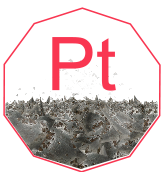Platinum

Platinum (Pt)
General Information
- Symbol: Pt
- Atomic Number: 78
- Atomic Weight: 195.084 u
- Element Category: Transition metal
- Group: 10
- Period: 6
- Block: d-block
Physical Properties
- Appearance: Silvery-white metallic
- Density: 21.45 g/cm³
- Melting Point: 1768.3 °C (3214.9 °F)
- Boiling Point: 3825 °C (6917 °F)
- Phase at STP: Solid
- Electron Configuration: [Xe] 4f¹⁴ 5d⁹ 6s¹
- Oxidation States: +2 (most common), +4, +3, +6, 0
Chemical Properties
- Reactivity: Platinum is highly resistant to corrosion and oxidation. It does not react with most acids, including hydrochloric acid and nitric acid, but it can dissolve in aqua regia, a mixture of hydrochloric and nitric acid.
- Compounds: Forms compounds such as platinum(II) chloride (PtCl₂), platinum(IV) oxide (PtO₂), and platinum hexafluoride (PtF₆).
Uses and Applications
- Catalysts: Widely used as a catalyst in catalytic converters for automobiles, in the petroleum industry for refining, and in various chemical reactions.
- Jewelry: Valued for its aesthetic appeal, durability, and resistance to tarnish, making it a popular choice for fine jewelry.
- Electronics: Used in electronics, especially in hard disks, thermocouples, and fuel cells.
- Medical Devices: Utilized in medical devices, including pacemakers and dental crowns, due to its biocompatibility.
- Laboratory Equipment: Used in laboratory equipment, such as crucibles and electrodes, due to its high melting point and chemical inertness.
Occurrence and Extraction
- Natural Occurrence: Found in alluvial deposits and in ores such as sperrylite (PtAs₂) and cooperite (PtS). Often found with other platinum group metals.
- Extraction: Extracted through a complex process that involves crushing the ore, flotation, and several stages of chemical treatment, including smelting and refining.
Isotopes
- Stable Isotopes: Platinum has six stable isotopes: Platinum-190, Platinum-192, Platinum-194, Platinum-195, Platinum-196, and Platinum-198.
- Radioactive Isotopes: Platinum-193 is a notable radioactive isotope used in scientific research.
Safety and Handling
- Hazards: Platinum metal is generally considered non-toxic, but platinum compounds can be toxic if ingested or inhaled. Some compounds are also known allergens.
- Precautions: Handle platinum compounds with appropriate protective equipment to avoid exposure to dust or fumes.
History
- Discovery: Known to pre-Columbian South American civilizations. Rediscovered in Europe in the 18th century.
- Name Origin: Derived from the Spanish word “platina,” meaning little silver.
Additional Facts
- Crystal Structure: Face-centered cubic (fcc)
- Magnetic Properties: Paramagnetic
- Thermal Conductivity: High, about 72 W/m·K
- Electrical Resistivity: About 105 nΩ·m at room temperature
Summary
Platinum is a dense, highly corrosion-resistant transition metal with significant applications in catalysis, jewelry, electronics, and medical devices. It is found in alluvial deposits and certain ores, and extracted through a complex refining process. Platinum’s durability, biocompatibility, and resistance to tarnish make it valuable in various industrial and commercial applications.
40 Question and Answer Pairs About Platinum
What is the atomic number of Platinum?
- 78
What is the symbol for Platinum?
- Pt
What is the atomic weight of Platinum?
- 195.084 u
In which group of the periodic table is Platinum found?
- Group 10
What period is Platinum in?
- Period 6
What block does Platinum belong to?
- d-block
What is the melting point of Platinum?
- 1768.3 °C (3214.9 °F)
What is the boiling point of Platinum?
- 3825 °C (6917 °F)
What is the density of Platinum?
- 21.45 g/cm³
What is the electron configuration of Platinum?
- [Xe] 4f¹⁴ 5d⁹ 6s¹
What are the common oxidation states of Platinum?
- +2, +4, +3, +6, 0
What is the appearance of Platinum?
- Silvery-white metallic
Is Platinum reactive with air?
- No, it is highly resistant to corrosion and oxidation.
Name a compound of Platinum.
- Platinum(II) chloride (PtCl₂)
What is a common use of Platinum in catalysis?
- Used in catalytic converters for automobiles.
How is Platinum used in jewelry?
- Valued for its aesthetic appeal, durability, and resistance to tarnish.
What role does Platinum play in electronics?
- Used in hard disks, thermocouples, and fuel cells.
How is Platinum used in medical devices?
- Utilized in pacemakers and dental crowns due to its biocompatibility.
What application does Platinum have in laboratory equipment?
- Used in crucibles and electrodes.
Name a mineral that contains Platinum.
- Sperrylite (PtAs₂)
How is Platinum extracted from ores?
- Through crushing, flotation, and chemical treatment, including smelting and refining.
What is the most stable isotope of Platinum?
- Platinum-195
Name a radioactive isotope of Platinum used in research.
- Platinum-193
What safety hazard is associated with Platinum compounds?
- Some compounds can be toxic if ingested or inhaled and are known allergens.
Where does the name Platinum come from?
- From the Spanish word “platina,” meaning little silver.
What is the crystal structure of Platinum?
- Face-centered cubic (fcc)
Is Platinum paramagnetic or diamagnetic?
- Paramagnetic
What is the thermal conductivity of Platinum?
- About 72 W/m·K
What is the electrical resistivity of Platinum at room temperature?
- About 105 nΩ·m
What is the primary oxidation state of Platinum?
- +2
Is Platinum found as a free element in nature?
- Yes, in alluvial deposits and certain ores.
What is the common name of Platinum(IV) oxide?
- PtO₂
What is a major application of Platinum hexafluoride (PtF₆)?
- Used in chemical synthesis and research.
How does Platinum benefit catalytic converters?
- It helps to reduce harmful emissions from automobiles.
What is the boiling point of Platinum in Kelvin?
- 4098 K
What group does Platinum belong to in the periodic table?
- Transition metals
What is the natural abundance of Platinum-195?
- About 33.8%
Can Platinum be used in high-temperature applications?
- Yes, due to its high melting point and stability.
What is the key property that makes Platinum valuable in jewelry?
- Its aesthetic appeal, durability, and resistance to tarnish.
How is Platinum used in the petroleum industry?
- As a catalyst in refining processes.






